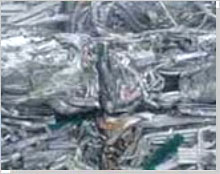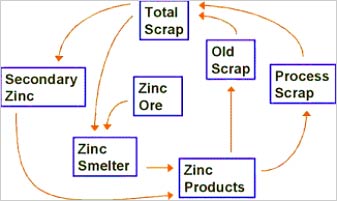 Zinc brings a multitude of social and economic benefits to society. Man has discovered a wide range of uses for this versatile natural element with valuable characteristics and properties for various industrial applications.
Zinc brings a multitude of social and economic benefits to society. Man has discovered a wide range of uses for this versatile natural element with valuable characteristics and properties for various industrial applications.
The most important use of zinc is in protecting steel from corrosion using hot-dip galvanizing technique. The metal is used to prolong the durability of steel, which is one of the most used materials on the planet. Both zinc and steel are 100% recyclable. The zinc-steel combination has considerable economic benefits in terms of life-cycle costs. Improved air quality in several industrialized countries, with diminishing levels of sulfur dioxide (SO2), means that today zinc coatings facilitate even longer protection for steel.
Increased attention to life-cycle costing is prompting the designers, specifiers and investors to prefer zinc-coated steel in many traditional and new applications, from electricity distribution poles to safety barriers, from construction to automobiles and from farm gates to ski-lifts.
The 27th most common element in the Earth's crust, Zinc is completely recyclable. According to estimates, at present, 70 % of the zinc produced originates from mined ores while 30 % comes from recycled or secondary zinc. The level of recycling is increasing in step with progress in zinc production technology and zinc recycling technology.

Today, more than 80 % of the zinc available for recycling is recycled. The metal is recycled at all the stages of production and use, for example, from scrap, which arises during the manufacturing of galvanized steel sheet, from scrap generated during production and installation processes, and from end-of-life products. Given below is the pie chart that describes the percentage of recovered zinc from different products manufactured with zinc.
The life of zinc-containing products varies and may range from 10 to 15 years for household appliances or cars, to over 100 years for zinc sheet used for roofing. Street lighting columns constructed of zinc-coated steel can remain in use for 40 years or more, and transmission towers for over 70 years. All these products tend to be replaced because of obsolescence, and not because the zinc has ceased to protect the underlying steel.
The presence of zinc coating on steel does not restrict its recyclability and all types of zinc-coated products can be recycled. Zinc coated steel is recycled along with other steel scrap during the processes of steel production - the zinc volatilizes and is then recovered. According to estimates, the supply of zinc-coated steel scrap is expected to double over the coming years, as more zinc-coated vehicles enter the recycling stream.
Types / Grades of Zinc ScrapDifferent grades and varieties of zinc scrap is used for recycling purposes and to recover pure zinc from the scrap. Given in the table below are some of the important grades / types of zinc scrap used in recycling - read more...
ProcessThe secondary zinc industry processes metal scrap for the recovery of zinc in the form of zinc oxide, zinc slabs, or zinc dust. The process of zinc recovery involves three general operations, viz. -
- Pretreatment
- Melting
- Refining
Secondary recovery starts with the separation of zinc-containing metals from other materials, typically by magnetics, sink-float, or hand sorting.
When non-ferrous metals have been mixed in shredder scrap, zinc metal can be separated from higher-melting metals, such as such copper and aluminum, through selective melting in a sweating furnace. A sweating furnace (rotary, reverberatory, or muffle furnace) slowly heats the scrap containing zinc and other metals to approximately 419.4°C; this temperature is adequate to melt zinc, however it is still below the melting point of the remaining metals.
In the case of zinc-galvanized steel, the zinc can be recovered largely in furnace dust after the scrap is charged into a steel making furnace and melted. Although it is expected that recycling will continue to be encouraged on the grounds of environmental sustainability.
Almost all of the zinc in electric arc furnace dust is first retrieved in an upgraded, impure zinc oxide product, and is then shipped to primary pyro-metallurgical zinc smelter for refinement to metal.
According to International Zinc Association, there are 50 secondary zinc operators in the world with varying recycling processes. New scrap is usually just remelted. In the case of mixed non-ferrous shredded metal scrap, zinc is separated by hand or magnetically, before it is re-refined by retorting. An important source of secondary zinc is flue dust from secondary electric arc furnaces for production of iron, using galvanized iron scrap.
Consumption of refined zinc metal in recent years has been slightly more than total metal production, perhaps due to the considerable amount of refined zinc includes zinc used directly in alloys irrespective of source material, whether concentrates, slags, residues or scrap.
The recycling picture for old scrap is quite confused. Based on the physical characteristics, most metallic zinc is theoretically recoverable, even after very long periods of use. According to International Lead and Zinc Study Group, the recovery efficiency for zinc, meaning the fraction of old scrap available for recycling, which is actually recycled, is 80 %; this is consistent with a very long lifetime of zinc products in use, as much as 100 years.
Zinc recovery from recycled galvanized iron and steel is becoming more and more important, but is still small; the remainder was primarily from brass products, flue dust, old die casting and old rolled zinc products.
A major problem for recyclers is that secondary zinc is almost invariably associated with other metals, including lead, copper, cadmium, arsenic and chromium.
Depending on the type of steel and the galvanizing process, between 10 % and 40 % of the total consumed zinc ends up in residues. Zinc that is metallurgically combined with steel during galvanizing process, cannot be easily separated from galvanized steel scrap. It is generally recovered from flue dust generated during the reprocessing of steel scrap.
Zinc containing materials are highly variable and include automobile scrap, brass scrap, flux skimming dross from the wet galvanizing process, zinc ash from the dry process, arc furnace dust, and so on. Composition may vary widely, and the recovery processes would have to be equally variable.
Scrap produced only at the end of the useful life of the product into which it is incorporated is more difficult to recover; and hence, only a small portion is recycled. Until 1993, about, all zinc used in galvanized steel products was lost either in landfills or in slag at steel scrap processing plants.
In recent years, zinc has been recovered from flue dust, and advanced technology to de-zinc galvanized steel has been developed. This new de-zincing technique should increase the relatively low recycling rate of old zinc scrap, which enhances the sustainability of primary zinc production.
Scrap Zinc Recycling - Industry Associations- American Zinc Association
- International Lead Zinc Research Organization, Inc. (ILZRO)
- Minerals, Metals & Materials Society (TMS)
- American Bureau of Metal Statistics
- Institute of Scrap Recycling Industries (DC) - ISRI
- AMM - American Metal Market
- Modern Metals
- Scrap (Magazine)
